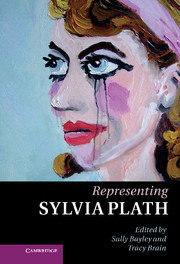18 results
Jennifer Price (January 26, 1940 – May 17, 2019)
-
- Journal:
- Journal of Roman Archaeology / Volume 33 / 2020
- Published online by Cambridge University Press:
- 05 October 2020, pp. 972-974
- Print publication:
- 2020
-
- Article
-
- You have access
- Export citation
Chapter 23 - Plath’s Journals
- from Part VI - Biographical Contexts
-
-
- Book:
- Sylvia Plath in Context
- Published online:
- 03 August 2019
- Print publication:
- 22 August 2019, pp 245-254
-
- Chapter
- Export citation
Thinking Narratively, Metaphorically and Allegorically through Poetry, Animation and Sound
-
- Journal:
- Journal of American Studies / Volume 47 / Issue 4 / November 2013
- Published online by Cambridge University Press:
- 29 October 2013, pp. 1231-1256
- Print publication:
- November 2013
-
- Article
- Export citation

Representing Sylvia Plath
-
- Published online:
- 07 September 2011
- Print publication:
- 11 August 2011
Index
-
- Book:
- Representing Sylvia Plath
- Published online:
- 07 September 2011
- Print publication:
- 11 August 2011, pp 244-249
-
- Chapter
- Export citation
Notes on contributors
-
- Book:
- Representing Sylvia Plath
- Published online:
- 07 September 2011
- Print publication:
- 11 August 2011, pp viii-xi
-
- Chapter
- Export citation
Frontmatter
-
- Book:
- Representing Sylvia Plath
- Published online:
- 07 September 2011
- Print publication:
- 11 August 2011, pp i-iv
-
- Chapter
- Export citation
Illustrations
-
- Book:
- Representing Sylvia Plath
- Published online:
- 07 September 2011
- Print publication:
- 11 August 2011, pp vii-vii
-
- Chapter
- Export citation
Acknowledgements
-
- Book:
- Representing Sylvia Plath
- Published online:
- 07 September 2011
- Print publication:
- 11 August 2011, pp xii-xiii
-
- Chapter
- Export citation
Introduction
-
-
- Book:
- Representing Sylvia Plath
- Published online:
- 07 September 2011
- Print publication:
- 11 August 2011, pp 1-10
-
- Chapter
- Export citation
Part II - Poetics and composition
-
- Book:
- Representing Sylvia Plath
- Published online:
- 07 September 2011
- Print publication:
- 11 August 2011, pp 89-90
-
- Chapter
- Export citation
Chapter 5 - ‘The trees of the mind are black, the light is blue’
- from Part II - Poetics and composition
-
-
- Book:
- Representing Sylvia Plath
- Published online:
- 07 September 2011
- Print publication:
- 11 August 2011, pp 91-109
-
- Chapter
- Export citation
Chapter 11 - Primary representations
- from Part III - Representation
-
- Book:
- Representing Sylvia Plath
- Published online:
- 07 September 2011
- Print publication:
- 11 August 2011, pp 203-234
-
- Chapter
- Export citation
Bibliography
-
- Book:
- Representing Sylvia Plath
- Published online:
- 07 September 2011
- Print publication:
- 11 August 2011, pp 235-243
-
- Chapter
- Export citation
Part III - Representation
-
- Book:
- Representing Sylvia Plath
- Published online:
- 07 September 2011
- Print publication:
- 11 August 2011, pp 165-166
-
- Chapter
- Export citation
Contents
-
- Book:
- Representing Sylvia Plath
- Published online:
- 07 September 2011
- Print publication:
- 11 August 2011, pp v-vi
-
- Chapter
- Export citation
Part I - Contexts
-
- Book:
- Representing Sylvia Plath
- Published online:
- 07 September 2011
- Print publication:
- 11 August 2011, pp 11-12
-
- Chapter
- Export citation
Abbreviations
-
- Book:
- Representing Sylvia Plath
- Published online:
- 07 September 2011
- Print publication:
- 11 August 2011, pp xiv-xiv
-
- Chapter
- Export citation



